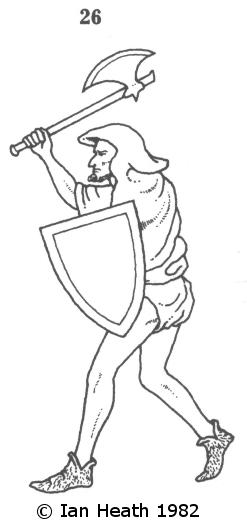
Try Amazon Audible Premium Plus and Get Up to Two Free Audiobooks
SCOTTISH RIBAULD, 14th CENTURY
An extract from Armies of the Middle Ages, volume 1by Ian Heath



26. SCOTTISH RIBAULD, 14th CENTURY
Taken from Edward II’s charter to Carlisle of 1316, depicting the unsuccessful Scottish siege of that place the previous year, this figure is probably representative of those foot-soldiers of the ‘commonalty’ for whom Froissart reserves the term ribaudaille. His costume appears to comprise a hooded cape, possibly a poor rendition by the original artist of an early brecan plaid drawn up over the head, worn over an undershirt apparently tied between the legs, the latter garment probably being a saffron-dyed leine croich. On his feet are rawhide brogues with the hair left on; these were customarily replaced several times on campaign from the hides of the cattle that were slaughtered for food.
Six such figures are depicted in the original; of these, 2 are engineers (one with a pickaxe, the other working a trebuchet), 2 are archers, one has a spear and shield and the last, depicted here, has an axe and shield. The shield is interesting in being a heater type. Oddly enough when shields are shown on Scottish grave effigies they too are heater types, and it would seem that what we today consider the typical Scottish targe was in fact only adopted during the 15th century, possibly originally in conjunction with the adoption of the longer spear or pike then being proposed. The parliamentary orders of 1471 and 1481 specify that men other than spearmen unable to use bows were to arm themselves with ‘a good axe and a leather targe to resist the shot of England’, the wood and leather targe to be copied from a master-pattern held by the sheriff of each district.
The axe was in fact a characteristically Scottish weapon. Froissart, for example, reports of the Scots at Neville’s Cross that they ‘had great axes sharp and hard, and gave with them many great strokes’; and writing of Otterburn he reports how a Scottish knight ‘took a little battle-axe that he carried at his back and handled it with his one hand quickly and deliverly, in the which feat Scots be well expert’.
Still writing of the Otterburn campaign, Froissart informs us that ‘in the use of the bow the Scots are little skilled; but they all carry axes over their shoulders with which they deal fearsome blows in battle.’ Nevertheless, he keeps describing Scottish infantry as ‘archers and other fighting men’, and certainly by the Statute of Arms of 1318 men possessing only the value of a cow were expected to provide themselves with either a spear or a (short) bow and a schaph of 24 arrows. Certainly James I (1424-37) even attempted, albeit unsuccessfully, to introduce the longbow, ordering that all men over 12 should practise with the bow and those between 16-60 should be ‘sufficiently provided with bows and sheaves of arrows’.